Bicycle Traffic Rules
Current Situation of Bicycle Accidents
In Tokyo, traffic accidents involving bicycles are rapidly increasing, accounting for approximately 46% of all traffic accidents in the year 2022.
Additionally, the number of fatalities from traffic accidents while riding bicycles is 30, accounting for approximately 23% of the total number of traffic accident fatalities.
Bicycle-related accidents often involve traffic violations such as running red lights and failing to stop, with approximately 64% of accidents involving bicycle traffic violations.
A similar trend is observed within the city, with 57 bicycle-related accidents out of a total of 181 traffic accidents in the year 2022, accounting for approximately 31%.
About 40% of bicycle-related accidents involve traffic violations such as failure to stop at intersections.
Bicycles are "light vehicles".
Bicycles are classified as "light vehicles" under the Road Traffic Act and are considered part of the "vehicle" category.
Like automobiles, which are part of the "vehicle" category, bicycles must also follow traffic signals and signs, and adhere to traffic rules.
Let's follow traffic rules and drive safely to avoid causing or being involved in traffic accidents.
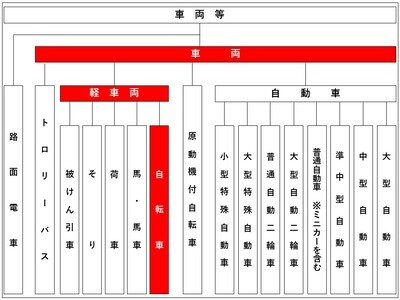
Let's check the passage location
1. The roadway is the principle, and let's travel on the left side of the roadway.
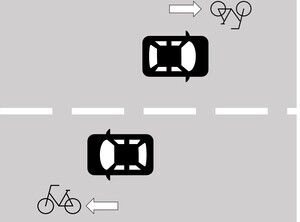
2 When there is a white line on the left side of the roadway?
There may be a white line drawn on the left side of the roadway.
The line drawn between the roadway and the sidewalk is called the "outer line of the roadway"; if there is no sidewalk, it is referred to as the "shoulder".
The shoulder is a space for pedestrians to walk.
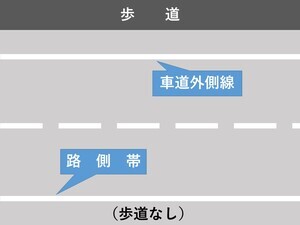
When there is a lane outside the roadway
You can travel on both the inner and outer sides of the road edge line.
However, since it is a left-side traffic system, you cannot drive against the flow.
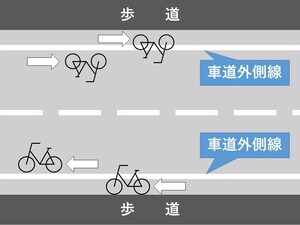

When there is a shoulder
The shoulder is a space for pedestrians to walk, but bicycles can also pass through the shoulder.
However, it is stated that "when passing through the shoulder, one must proceed at a speed and in a manner that does not obstruct pedestrian traffic." Therefore, basically, let's avoid entering the shoulder and use the roadway.
When passing through the shoulder, you must use the shoulder designated on the left side of the roadway.
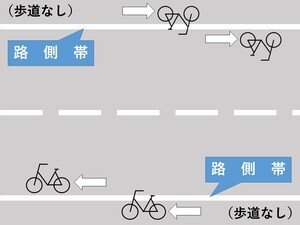

Let's observe the "temporary suspension"
Bicycles must also come to a stop at stop signs.
Always obey the stop sign and come to a complete stop before the stop line, checking for safety to the left and right.
If you cannot see the situation to the left and right from the stop line, slowly move to a point where you can confirm safety on both sides, and check for safety visually.
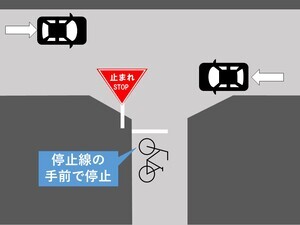

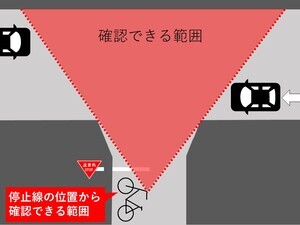
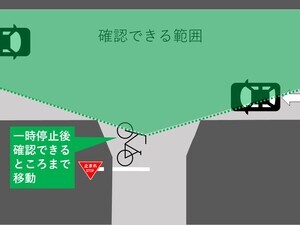
Traffic lights to follow
1 What traffic signals should you follow when driving on the roadway?
When passing through the roadway, follow the traffic signals for oncoming vehicles.
When the red light is on, let's stop before the stop line.
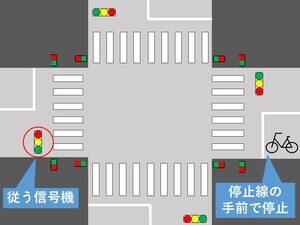
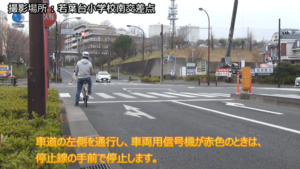
2 What traffic signals should you follow when walking on the sidewalk?
When walking on the sidewalk, follow the pedestrian signal facing you.
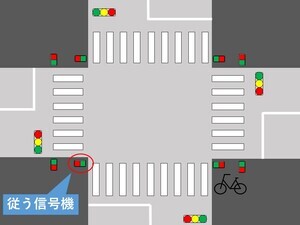

How to Turn Right at an Intersection
1 Intersection with Traffic Lights
When turning right at an intersection with a traffic signal,
- Follow the green light of the traffic signal for oncoming vehicles, keep as close to the left edge of the road as possible while going straight, and then turn in the direction you want to go at the edge of the roadway.
- Proceed straight after confirming that the traffic signal for oncoming vehicles has changed from red to green.
Note: Right turns like those of a car are not allowed.
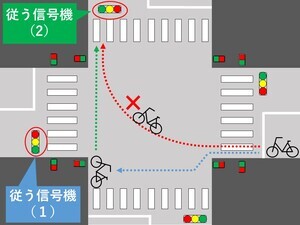
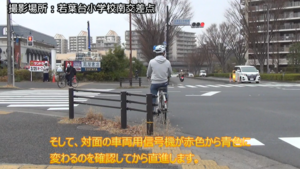
2 Unsignalized Intersections
When turning right at an intersection without a traffic signal, keep as far to the left side of the road as possible, go straight, then turn in the direction you want to go at the edge of the roadway, and proceed straight again.

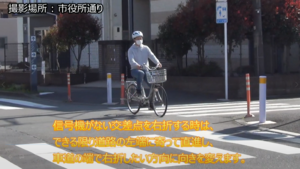
How to Cross the Pedestrian Crossing
1. What should you do when passing the crosswalk ahead?
When passing through the roadway and approaching a crosswalk ahead, you must come to a complete stop at the stop line of the crosswalk if there are pedestrians or others crossing or attempting to cross, and you must not obstruct their passage.
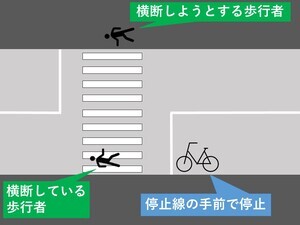
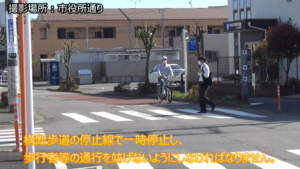
2. What to do when passing over a crosswalk?
When there are no pedestrians on the crosswalk and there is no risk of obstructing pedestrian passage, you may cross the crosswalk while remaining in the vehicle.
However, the crosswalk is a place for pedestrians to cross the road.
If there is a risk of obstructing pedestrians crossing, you cannot pass while remaining in the vehicle, so please get off and walk while pushing.
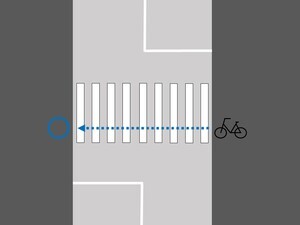
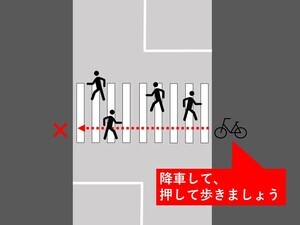
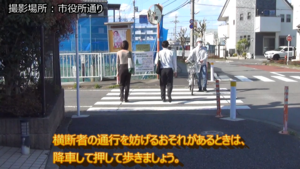
How to Use the Left Turn Lane
When going straight at an intersection with a left turn lane, as shown in the diagram, you should proceed in the left turn lane instead of the straight lane.

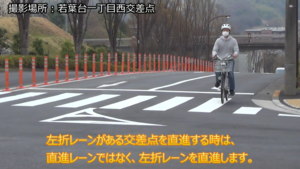
Rules for Carrying Infants on Bicycles
There have been tragic accidents where young children have died due to not being properly secured in a bicycle.
Let's check the rules for carrying infants on bicycles.
- Children who can be carried are those who have not yet reached the age of starting elementary school.
- Drivers must be 16 years or older.
- When transporting one infant, a child seat must be used.
- When carrying two infants, a bicycle designed for two infants (a bicycle equipped with special structures or devices necessary for a riding device for the operator and two infant seats) must be used.
- When riding while carrying a child on your back, the child must be under 4 years old and must be securely strapped with a cord or similar.
When it is possible to carry infants


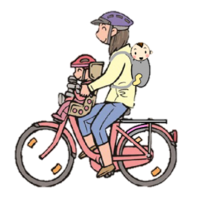

If you cannot carry infants


This way of riding is also prohibited






Effort to Wear Helmets
About 70% of the fatalities in traffic accidents while riding a bicycle suffer fatal head injuries, and the fatality rate without a helmet is approximately 2.3 times higher compared to when wearing one.
As a result, the Road Traffic Act has been amended, and from April 1, 2023, wearing a helmet while riding a bicycle will be a duty of effort for all ages.
A helmet can come off in an accident if the chin strap is not fastened.
Make sure to tighten the chin strap properly.
Please let us know your feedback on how to make our website better.
Inquiries about this page
Inagi City, Urban Development Department, Management Division
2111 Higashi-Naganuma, Inagi City, Tokyo 206-8601
Phone number: 042-378-2111 Fax number: 042-377-4781
Contact the Management Division, Department of Urban Development, Inagi City



















